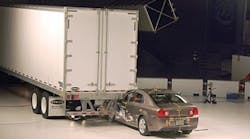The National Highway Traffic Safety Administration (NHTSA) has granted a Truck Safety Coalition request to improve the safety of rear impact (underride) guards by initiating rulemaking on them.
NHTSA is planning on issuing two separate notices—an advanced notice of proposed rulemaking pertaining to rear impact guards and other safety strategies for single unit trucks, and a notice of proposed rulemaking focusing on rear impact guards on trailers and semitrailers.
NHTSA is still evaluating the petitioners' request to improve side guards and front override guards and will issue a separate decision on those aspects of the petition at a later date.
The request to initiate rulemaking on rear impact guards on trailers and single unit trucks was granted today.
On September 12, 2013, Truck Safety Coalition members met with the Secretary of Transportation to discuss their petition for rulemaking on truck safety issues. The petitioners requested a standard requiring improved underride guards be issued, and that the Department of Transportation begin studies and rulemakings for side guards and front override guards.
In additional correspondence to the Department of Transportation following the meeting, the petitioners stated that if the Federal motor vehicle safety standards (FMVSSs) for rear underride guards were amended to be equivalent to Canadian motor vehicle safety standards, injuries and fatalities could be avoided. They stated that all trucks and trailers should be required to be equipped with energy-absorbing rear impact guards mounted 16 inches from the ground with vertical supports mounted 18 inches from the side edges.
On May 5, the petitioners presented the Secretary of Transportation with more than 11,000 identical petitions from members of the public, again requesting the initiation of a rulemaking on rear impact guards. They requested that the Department adopt a requirement for improved rear impact guards and that the Department begin the process of improving side guards and front override guards.
In their petition, the Petitioners also requested that the Department raise the minimum insurance liability limits that truck drivers are required to carry and take certain actions to improve enforcement of hours of service limits and reduce truck driver fatigue, both of which are actions under the jurisdiction of the Federal Motor Carrier Safety Administration (FMCSA), not NHTSA. Consequently, these two requests are not addressed in this notice, which is not intended to either grant or deny the petitioners request on these two actions.
The standards for rear impact protection that NHTSA will consider in its rulemaking are FMVSS No. 223, Rear Impact Guards, and FMVSS No. 224, Rear Impact Protection. FMVSS No. 223 specifies equipment requirements for rear impact guards for trailers and semitrailers. FMVSS No. 224 specifies requirements for the installation of rear impact guards for trailers and semitrailers.
The major difference between the Canadian motor vehicle safety standard for rear impact protection (No. 223) on trailers and the relevant FMVSSs is that Canadian underride guards are required to meet higher strength and energy absorption requirements than U.S. underride guards.
As part of its analysis of the petition, NHTSA reviewed recent research it conducted on rear impact protection and rear underride occurrences. Specifically, NHTSA considered a 2013 University of Michigan Transportation Research Institute (UMTRI) report, a 2012 UMTRI report, a 2011 Insurance Institute for Highway Safety report on rear impact protection, and a 2002 Transport Canada report. The data and analysis in these reports indicate that amending the FMVSSs pertaining to rear impact protection could potentially improve the safety of light-duty vehicles underriding trailers in rear end crashes.
As part of its rulemaking effort, NHTSA will take into account currently available data and seek additional information from the public, including Canadian officials. The agency plans to pursue rulemaking through two separate notices on distinct applications of rear impact protection. The first notice would be an advanced notice of proposed rulemaking pertaining to rear impact guards for single unit trucks and other safety strategies not currently applicable to single unit trucks. The second notice would be a notice of proposed rulemaking focusing on rear impact guards for trailers and semitrailers.










